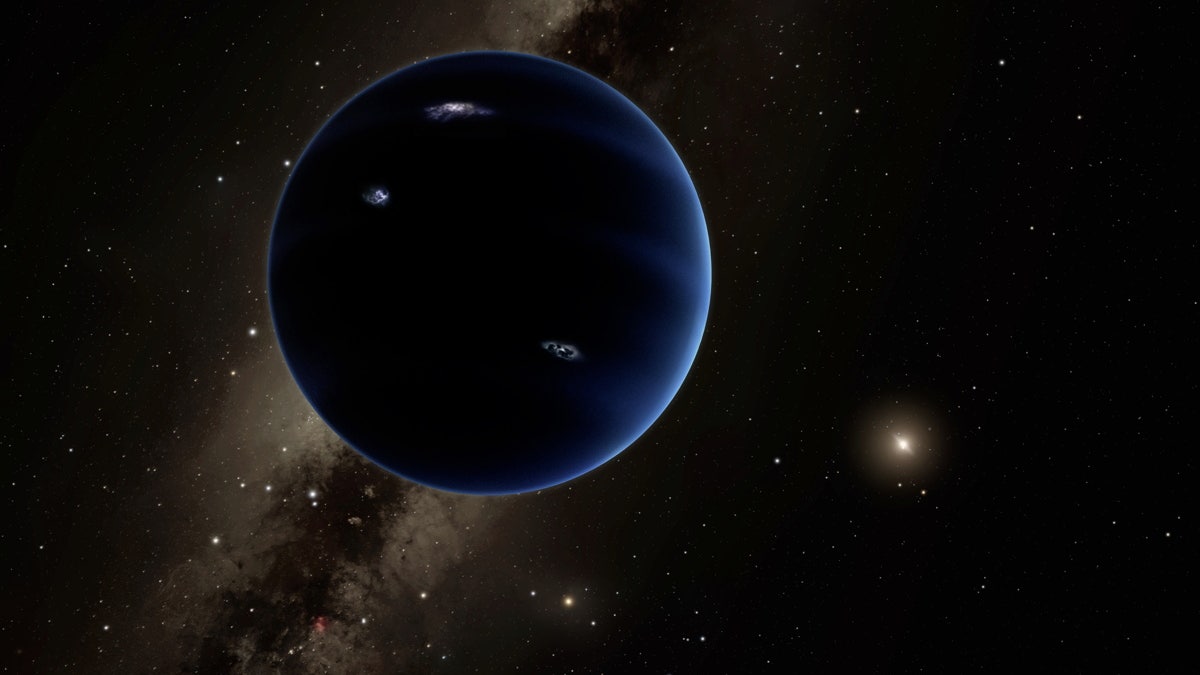
Artist's impression of the hypothetical Planet Nine, a roughly Neptune-mass world that may lie undiscovered in the outer solar system. (Caltech/R. Hurt (IPAC))
There has been much speculation about the existence of Planet Nine and its impact on distant objects in the solar system. But a new study suggests that some of the farthest celestial bodies in our planetary system aren't being impacted by this yet-to-be-discovered planet, but rather another mysterious object deep in the echoes of space.
The study, published in the Astronomical Journal, suggests the six known objects in the Kuiper Belt, all of which have elliptical orbits that point in the same direction, could be affected by other trans-Neptunian Objects (TNOs) and not a giant planet.
"If you remove planet nine from the model and instead allow for lots of small objects scattered across a wide area, collective attractions between those objects could just as easily account for the eccentric orbits we see in some TNOs," said study co-author, Antranik Sefilian, a PhD student in Cambridge's Department of Applied Mathematics and Theoretical Physics, in a statement.
PLANET NINE MAY EXIST, BUT IT MIGHT BE HIDING BEHIND NEPTUNE
Sefilian added that since Planet Nine has so far eluded detection, the researchers wanted to see if there was another possibility for the disturbances of the TNOs. "We thought, rather than allowing for a ninth planet, and then worry about its formation and unusual orbit, why not simply account for the gravity of small objects constituting a disc beyond the orbit of Neptune and see what it does for us?"
A copy of the study can be read in its entirety here.
Researchers have found the existence of 30 TNOs and there may be more. Given the combined gravitational pull of these objects and a potential disk of material in the furthest reaches of the solar system, it provides a possibility that Planet Nine may not exist at all.
"The problem is when you're observing the disc from inside the system, it's almost impossible to see the whole thing at once. While we don't have direct observational evidence for the disc, neither do we have it for Planet Nine, which is why we're investigating other possibilities," Sefilian said. "Nevertheless, it is interesting to note that observations of Kuiper belt analogues around other stars, as well as planet formation models, reveal massive remnant populations of debris."
PLANET NINE AND SIX OTHER BAFFLING SPACE MYSTERIES SCIENTISTS CAN'T EXPLAIN
The mass of the Kuiper Belt is thought to be anywhere between 3 and 10 times that of Earth, according to the research. However, other studies suggest that it is less than 10 percent of Earth, according to Space.com.
Despite the lack of evidence of both the disk and Planet Nine, also colloquially referred to as Planet X, Sefilian concedes the possibility that both a disk and a ninth planet could be out there, we just have yet to find them.
"It's also possible that both things could be true - there could be a massive disc and a ninth planet," he said. "With the discovery of each new TNO, we gather more evidence that might help explain their behavior."
THE GOBLIN DWARF PLANET MAY LEAD TO PLANET NINE DISCOVERY
Evidence of Planet Nine?
In October 2017, Caltech planetary astrophysicist Konstantin Batygin said that there are "five different lines of observational evidence" that point to the existence of Planet X/Nine.
The five lines of evidence are:
- Six known objects in the Kuiper Belt, all of which have elliptical orbits that point in the same direction.
- The orbits of the objects are all tilted the same way; 30 degrees "downward."
- Computer simulations that show there are more objects "tilted with respect to the solar plane."
- Planet Nine could be responsible for the tilt of the planets in our solar system; the plane of the planet's orbit is tilted about 6 degrees compared to the Sun's equator
- Some objects from the Kuiper Belt orbit in the opposite direction from everything else in the solar system.
"No other model can explain the weirdness of these high-inclination orbits," Batygin said at the time. "It turns out that Planet Nine provides a natural avenue for their generation. These things have been twisted out of the solar system plane with help from Planet Nine and then scattered inward by Neptune."
In October 2017, NASA released a statement saying that Planet Nine may be 20 times further from the Sun than Neptune is, going so far as to say "it is now harder to imagine our solar system without a Planet Nine than with one."
CLICK HERE TO GET THE FOX NEWS APP
Follow Chris Ciaccia on Twitter @Chris_Ciaccia
